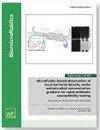基于微流控技术的患者衍生疾病检测工具,用于深度学习辅助精准医疗
IF 2.6
4区 工程技术
Q2 BIOCHEMICAL RESEARCH METHODS
引用次数: 0
摘要
癌症的时空异质性加剧了对疗法的抵抗。为了实现对癌症预后和治疗的常规评估,我们展示了智能疾病检测工具(IDDT)的开发过程,这是一种基于微流控的肿瘤模型,集成了深度学习辅助算法分析。IDDT 通过来自不同类型癌症(如乳腺癌、胃癌和肺癌)患者和健康供体的液态血液活检样本(n = 71)进行了临床验证,需要低样本量(∼200 μl)和高通量三维肿瘤培养系统(∼300 个肿瘤簇)。为了支持自动算法分析、智能决策和精确分割,我们设计并开发了一种集成式深度神经网络,其中包括基于掩膜区域的卷积神经网络(Mask R-CNN)、视觉转换器和任意分割模型(Segment Anything Model,SAM)。我们的方法大大减少了高达 90% 的人工标注时间,平均交叉联合时间(mIoU)高达 0.902,并且在临床队列分类中可立即获得结果(每张图像 2 秒)。IDDT 可以在各自的治疗周期和癌症分期内对健康供体(n = 12)和癌症患者(n = 55)进行准确分层,从而实现高精确度(∼99.3%)和高灵敏度(∼98%)。我们设想,我们以患者为中心的 IDDT 将提供一种智能、无标记、经济高效的方法,帮助临床医生做出精确的医疗决策,并为每位患者量身定制治疗策略。本文章由计算机程序翻译,如有差异,请以英文原文为准。
Microfluidics-based patient-derived disease detection tool for deep learning-assisted precision medicine
Cancer spatial and temporal heterogeneity fuels resistance to therapies. To realize the routine assessment of cancer prognosis and treatment, we demonstrate the development of an Intelligent Disease Detection Tool (IDDT), a microfluidic-based tumor model integrated with deep learning-assisted algorithmic analysis. IDDT was clinically validated with liquid blood biopsy samples (n = 71) from patients with various types of cancers (e.g., breast, gastric, and lung cancer) and healthy donors, requiring low sample volume (∼200 μl) and a high-throughput 3D tumor culturing system (∼300 tumor clusters). To support automated algorithmic analysis, intelligent decision-making, and precise segmentation, we designed and developed an integrative deep neural network, which includes Mask Region-Based Convolutional Neural Network (Mask R-CNN), vision transformer, and Segment Anything Model (SAM). Our approach significantly reduces the manual labeling time by up to 90% with a high mean Intersection Over Union (mIoU) of 0.902 and immediate results (<2 s per image) for clinical cohort classification. The IDDT can accurately stratify healthy donors (n = 12) and cancer patients (n = 55) within their respective treatment cycle and cancer stage, resulting in high precision (∼99.3%) and high sensitivity (∼98%). We envision that our patient-centric IDDT provides an intelligent, label-free, and cost-effective approach to help clinicians make precise medical decisions and tailor treatment strategies for each patient.
求助全文
通过发布文献求助,成功后即可免费获取论文全文。
去求助
来源期刊

Biomicrofluidics
生物-纳米科技
CiteScore
5.80
自引率
3.10%
发文量
68
审稿时长
1.3 months
期刊介绍:
Biomicrofluidics (BMF) is an online-only journal published by AIP Publishing to rapidly disseminate research in fundamental physicochemical mechanisms associated with microfluidic and nanofluidic phenomena. BMF also publishes research in unique microfluidic and nanofluidic techniques for diagnostic, medical, biological, pharmaceutical, environmental, and chemical applications.
BMF offers quick publication, multimedia capability, and worldwide circulation among academic, national, and industrial laboratories. With a primary focus on high-quality original research articles, BMF also organizes special sections that help explain and define specific challenges unique to the interdisciplinary field of biomicrofluidics.
Microfluidic and nanofluidic actuation (electrokinetics, acoustofluidics, optofluidics, capillary)
Liquid Biopsy (microRNA profiling, circulating tumor cell isolation, exosome isolation, circulating tumor DNA quantification)
Cell sorting, manipulation, and transfection (di/electrophoresis, magnetic beads, optical traps, electroporation)
Molecular Separation and Concentration (isotachophoresis, concentration polarization, di/electrophoresis, magnetic beads, nanoparticles)
Cell culture and analysis(single cell assays, stimuli response, stem cell transfection)
Genomic and proteomic analysis (rapid gene sequencing, DNA/protein/carbohydrate arrays)
Biosensors (immuno-assay, nucleic acid fluorescent assay, colorimetric assay, enzyme amplification, plasmonic and Raman nano-reporter, molecular beacon, FRET, aptamer, nanopore, optical fibers)
Biophysical transport and characterization (DNA, single protein, ion channel and membrane dynamics, cell motility and communication mechanisms, electrophysiology, patch clamping). Etc...
 求助内容:
求助内容: 应助结果提醒方式:
应助结果提醒方式:


